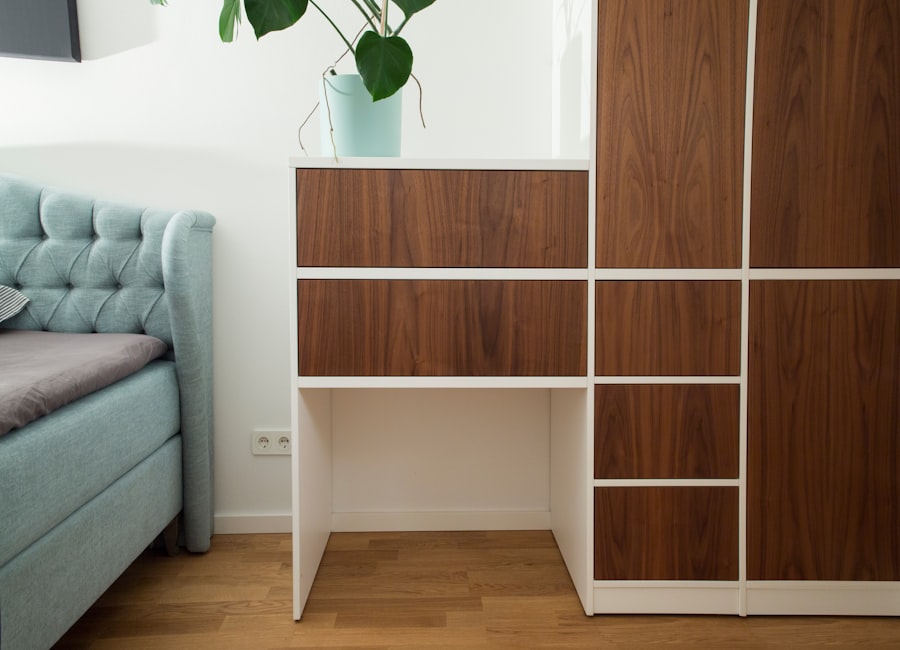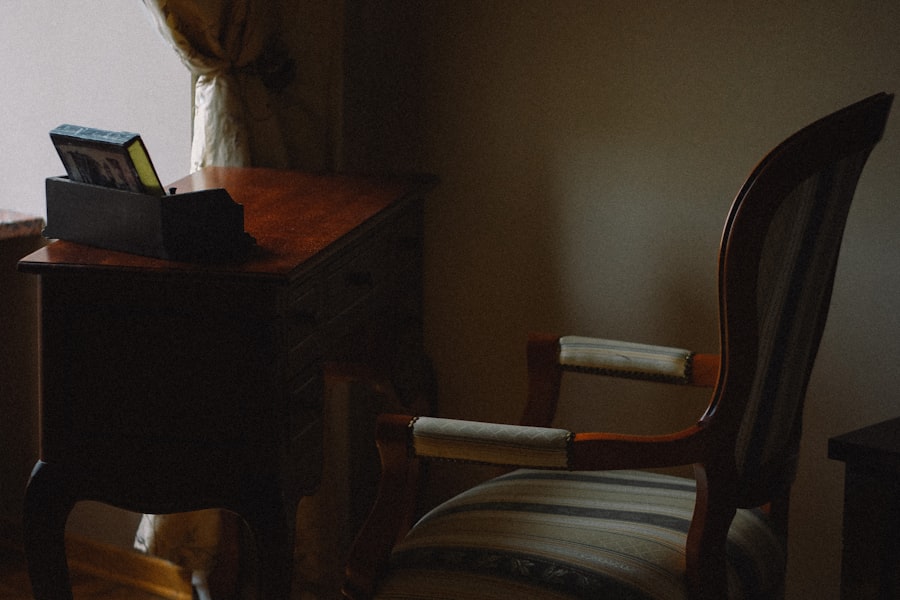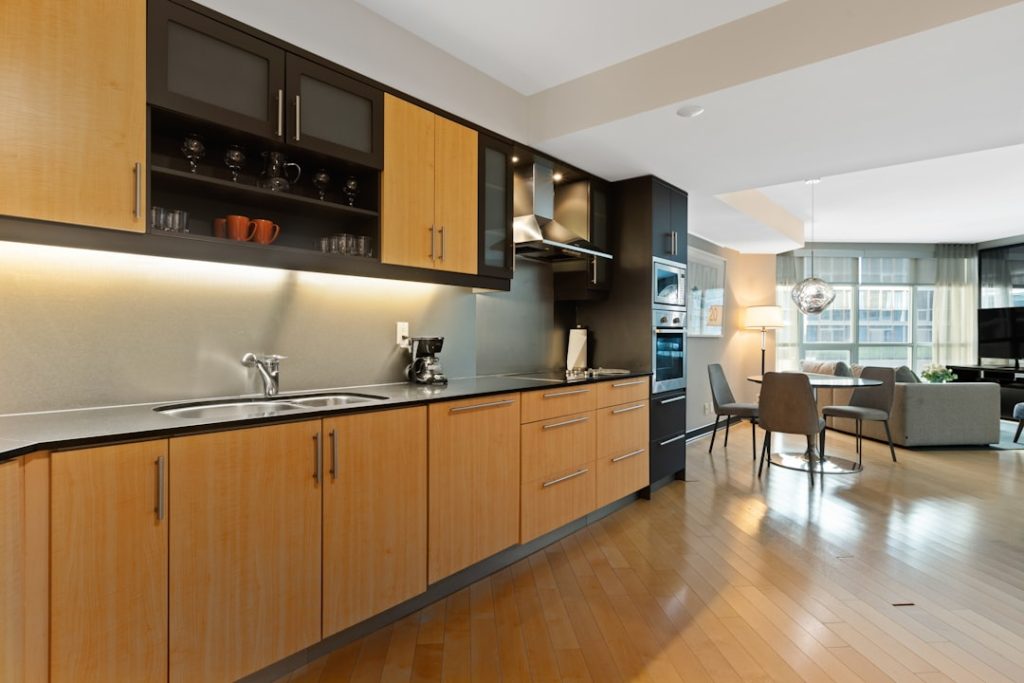The design of office cabinetry has undergone significant transformations over the decades, reflecting broader changes in workplace culture, technology, and aesthetics. In the early 20th century, office furniture was predominantly utilitarian, characterized by heavy wooden desks and bulky filing cabinets that prioritized function over form. These pieces were often made from solid hardwoods, emphasizing durability and longevity.
The industrial revolution played a pivotal role in this evolution, as mass production techniques allowed for the creation of standardized office furniture that could be produced at scale. This period saw the rise of metal filing cabinets, which offered a more modern alternative to wooden designs, providing both security and a sleek appearance. As the mid-20th century approached, the advent of modernism began to influence office cabinetry design.
Designers like Charles and Ray Eames introduced innovative materials such as molded plywood and fiberglass, which not only lightened the visual weight of office furniture but also allowed for more ergonomic shapes. The focus shifted towards creating environments that fostered collaboration and creativity, leading to the development of modular cabinetry systems that could be easily reconfigured to suit different needs. This era marked a significant departure from rigid, hierarchical office layouts, paving the way for open-plan spaces that encouraged interaction among employees.
The evolution of office cabinetry thus mirrors the changing dynamics of work itself, moving from a strictly functional approach to one that embraces flexibility and adaptability.
Key Takeaways
- Office cabinetry design has evolved to integrate technology and adapt to diverse work environments.
- Customization and ergonomic features are key to enhancing functionality and user comfort.
- Balancing aesthetics with practicality ensures office cabinetry meets both style and operational needs.
- Sustainable, eco-friendly materials are increasingly prioritized in modern cabinetry design.
- Innovative storage solutions and emerging trends focus on maximizing space and future-proofing office setups.
Incorporating Technology into Office Cabinetry
In recent years, the integration of technology into office cabinetry has become increasingly prevalent, reflecting the digital transformation of workplaces. Modern office cabinets are no longer just static storage solutions; they are evolving into multifunctional units equipped with smart technology. For instance, many contemporary designs now feature built-in charging stations for electronic devices, allowing employees to keep their gadgets powered without cluttering their workspaces with cords and chargers.
This seamless integration of technology not only enhances convenience but also promotes a more organized and efficient work environment. Moreover, advancements in technology have led to the development of smart cabinets that can monitor inventory levels and usage patterns. These cabinets utilize sensors and IoT (Internet of Things) connectivity to provide real-time data on what items are being accessed most frequently, enabling businesses to optimize their storage solutions accordingly.
For example, a law firm might use smart cabinetry to track the usage of legal documents and files, ensuring that essential materials are always readily available while minimizing unnecessary clutter. This technological integration not only streamlines operations but also supports a more data-driven approach to office management.
Customizing Office Cabinetry for Different Work Environments

The customization of office cabinetry is essential for accommodating the diverse needs of various work environments. Different industries have unique requirements that dictate the design and functionality of cabinetry. For instance, a creative agency may prioritize open shelving and collaborative workspaces that encourage brainstorming and idea sharing, while a financial institution might require secure filing systems with locking mechanisms to protect sensitive information.
Custom cabinetry allows businesses to tailor their storage solutions to fit their specific operational needs. In addition to industry-specific requirements, customization also extends to individual employee preferences. As workplaces become more diverse, there is an increasing recognition of the importance of personalizing workspaces to enhance employee satisfaction and productivity.
For example, adjustable shelving heights can cater to employees of different statures or preferences for accessibility. Furthermore, incorporating elements such as color schemes or branding into cabinetry design can foster a sense of belonging and identity within the workplace. By investing in customized office cabinetry, organizations can create environments that not only meet functional demands but also resonate with their workforce on a personal level.
Balancing Aesthetics and Functionality in Office Cabinetry
| Metric | Description | Importance | Typical Range | Impact on Aesthetics | Impact on Functionality |
|---|---|---|---|---|---|
| Material Quality | Type and grade of materials used (wood, metal, laminate) | High | Medium to High | Enhances visual appeal and texture | Determines durability and maintenance |
| Storage Capacity | Volume and number of compartments/drawers | High | 20-100 liters per unit | Can affect cabinet bulkiness | Directly impacts usability and organization |
| Design Style | Modern, traditional, minimalist, etc. | Medium | Varies by office theme | Defines overall office ambiance | May limit or enhance ergonomic features |
| Ergonomics | Ease of access, height, and reachability | High | Standard heights 28-36 inches | Subtle design adjustments needed | Improves user comfort and efficiency |
| Finish and Color | Surface treatment and color palette | Medium | Neutral to bold colors | Sets tone and mood of space | May affect visibility of wear and tear |
| Hardware Quality | Handles, hinges, locks | Medium | Standard to premium grade | Contributes to style and detail | Ensures smooth operation and security |
| Cost Efficiency | Balance between budget and quality | High | Varies widely | May limit design options | Impacts long-term maintenance and replacement |
Striking a balance between aesthetics and functionality is a critical consideration in office cabinetry design. While it is essential for cabinetry to serve its primary purpose of storage and organization, the visual appeal of these pieces can significantly impact the overall atmosphere of an office space. A well-designed cabinet can enhance the aesthetic quality of a room, contributing to a cohesive design theme that reflects the company’s brand identity.
For instance, sleek, minimalist cabinetry made from high-quality materials can convey professionalism and sophistication in corporate environments. However, aesthetics should not come at the expense of functionality. Office cabinetry must be designed with practical considerations in mind, ensuring that it meets the everyday needs of employees.
Features such as adjustable shelves, easy-to-open drawers, and efficient use of space are crucial for maximizing usability. For example, a cabinet designed with pull-out shelves can make accessing items easier while minimizing strain on employees’ backs. Ultimately, successful office cabinetry design harmonizes beauty with practicality, creating spaces that are both visually appealing and conducive to productivity.
Sustainable and Eco-Friendly Materials in Office Cabinetry Design
The growing emphasis on sustainability has significantly influenced office cabinetry design in recent years. As organizations become more aware of their environmental impact, there is an increasing demand for eco-friendly materials in furniture production. Manufacturers are responding by sourcing sustainable materials such as bamboo, reclaimed wood, and recycled metals for their cabinetry designs.
Bamboo, in particular, has gained popularity due to its rapid growth rate and renewability, making it an excellent alternative to traditional hardwoods. In addition to material choices, sustainable practices extend to the manufacturing processes used in creating office cabinetry. Many companies are adopting environmentally responsible practices such as low-VOC (volatile organic compounds) finishes and adhesives that minimize harmful emissions during production.
This commitment to sustainability not only benefits the environment but also appeals to consumers who prioritize eco-conscious choices in their purchasing decisions. By incorporating sustainable materials and practices into office cabinetry design, businesses can contribute positively to environmental conservation while enhancing their corporate social responsibility profile.
Innovative Storage Solutions for Modern Office Cabinetry

As workspaces evolve to accommodate new ways of working—such as remote work and flexible schedules—innovative storage solutions have emerged as essential components of modern office cabinetry design. Traditional filing cabinets are being reimagined into multifunctional units that serve various purposes beyond mere storage. For instance, mobile cabinets on wheels allow for easy reconfiguration of office layouts, enabling teams to adapt their environments based on project needs or collaborative efforts.
Another innovative approach involves integrating technology into storage solutions through features like digital locks or biometric access systems that enhance security while providing ease of use. Additionally, vertical storage solutions are gaining traction as offices seek to maximize limited floor space. Wall-mounted cabinets or shelving units can help utilize vertical real estate effectively while keeping essential items within reach.
These innovative storage solutions not only address practical challenges but also contribute to a more dynamic and flexible workplace environment.
Ergonomic Considerations in Office Cabinetry Design
Ergonomics plays a vital role in the design of office cabinetry, as it directly impacts employee comfort and productivity. Poorly designed storage solutions can lead to physical strain or discomfort when accessing items frequently used throughout the workday. Therefore, incorporating ergonomic principles into cabinetry design is essential for promoting employee well-being.
Features such as adjustable shelving heights allow users to access items without excessive bending or stretching, reducing the risk of musculoskeletal injuries. Furthermore, the placement of cabinets should consider workflow patterns within the office space. For example, placing frequently used items within easy reach minimizes unnecessary movement and enhances efficiency during daily tasks.
Additionally, incorporating soft-close mechanisms on drawers can prevent slamming and reduce noise levels in shared workspaces, contributing to a more pleasant working environment. By prioritizing ergonomic considerations in office cabinetry design, organizations can create spaces that support employee health while fostering productivity.
Trends and Future Directions in Office Cabinetry Design
The future of office cabinetry design is poised for exciting developments as trends continue to evolve alongside changing workplace dynamics. One notable trend is the increasing emphasis on flexibility and adaptability in furniture design. As hybrid work models become more prevalent, cabinetry solutions that can easily transition between different configurations will be essential for accommodating diverse work styles and preferences.
Another emerging trend is the integration of biophilic design principles into office cabinetry. This approach seeks to connect indoor environments with nature by incorporating natural materials and elements that promote well-being. For instance, cabinetry designs featuring living plant walls or natural wood finishes can create a calming atmosphere that enhances employee satisfaction.
Additionally, advancements in technology will continue to shape the future of office cabinetry design. The rise of artificial intelligence and machine learning may lead to smarter storage solutions that anticipate user needs based on historical data or usage patterns. As organizations strive for greater efficiency and productivity in their operations, innovative cabinetry designs will play a crucial role in shaping the modern workplace landscape.
In conclusion, the evolution of office cabinetry design reflects broader trends in workplace culture and technology while addressing practical needs for functionality and aesthetics. As organizations continue to adapt to changing work environments, embracing customization, sustainability, ergonomics, and innovation will be key drivers in shaping the future of office cabinetry design.



